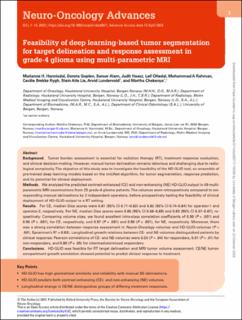| dc.description.abstract | Background
Tumor burden assessment is essential for radiation therapy (RT), treatment response evaluation, and clinical decision-making. However, manual tumor delineation remains laborious and challenging due to radiological complexity. The objective of this study was to investigate the feasibility of the HD-GLIO tool, an ensemble of pre-trained deep learning models based on the nnUNet-algorithm, for tumor segmentation, response prediction, and its potential for clinical deployment.
Methods
We analyzed the predicted contrast-enhanced (CE) and non-enhancing (NE) HD-GLIO output in 49 multi-parametric MRI examinations from 23 grade-4 glioma patients. The volumes were retrospectively compared to corresponding manual delineations by 2 independent operators, before prospectively testing the feasibility of clinical deployment of HD-GLIO-output to a RT setting.
Results
For CE, median Dice scores were 0.81 (95% CI 0.71–0.83) and 0.82 (95% CI 0.74–0.84) for operator-1 and operator-2, respectively. For NE, median Dice scores were 0.65 (95% CI 0.56–0,69) and 0.63 (95% CI 0.57–0.67), respectively. Comparing volume sizes, we found excellent intra-class correlation coefficients of 0.90 (P < .001) and 0.95 (P < .001), for CE, respectively, and 0.97 (P < .001) and 0.90 (P < .001), for NE, respectively. Moreover, there was a strong correlation between response assessment in Neuro-Oncology volumes and HD-GLIO-volumes (P < .001, Spearman’s R2 = 0.83). Longitudinal growth relations between CE- and NE-volumes distinguished patients by clinical response: Pearson correlations of CE- and NE-volumes were 0.55 (P = .04) for responders, 0.91 (P > .01) for non-responders, and 0.80 (P = .05) for intermediate/mixed responders.
Conclusions
HD-GLIO was feasible for RT target delineation and MRI tumor volume assessment. CE/NE tumor-compartment growth correlation showed potential to predict clinical response to treatment. | en_US |

